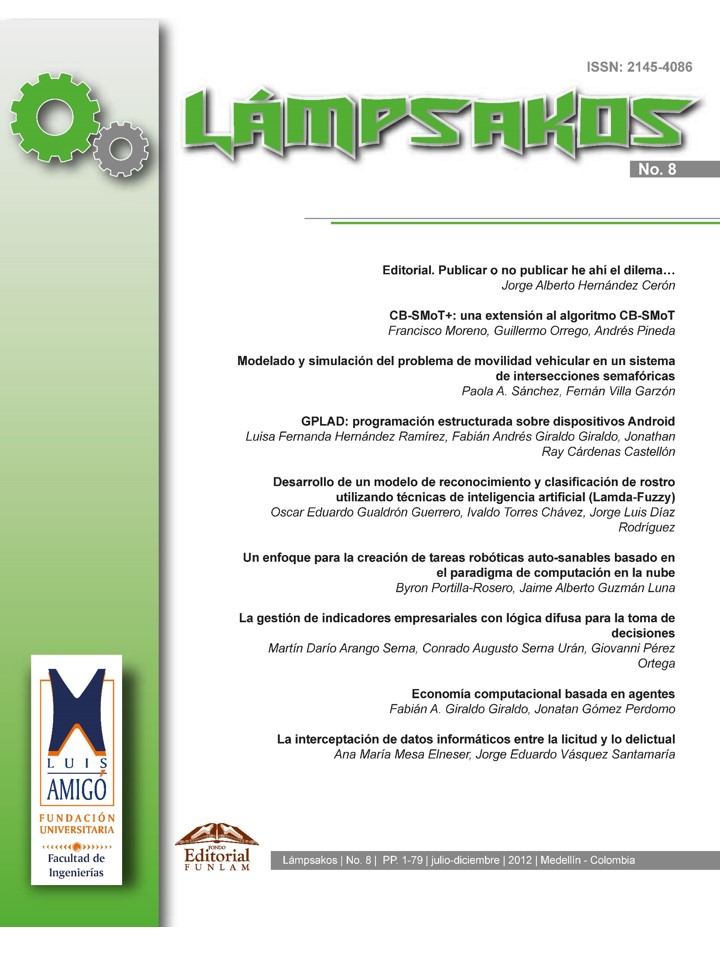La Gestión de Indicadores Empresariales con Lógica Difusa para la Toma de Decisiones
DOI:
https://doi.org/10.21501/21454086.678Keywords:
Balance Scorecard, lógica difusa, gestión de indicadores, sistema de inferencia difusa, modelo difuso tipo Mamdani,Abstract
En las organizaciones actuales la toma de decisiones está acompañada de cierto grado de incertidumbre, lo que no permite planificar sobre resultados ciertos. En algunas ocasiones medir estos resultados también implica incertidumbre asociada con la ambigüedad o subjetividad del instrumento utilizado. Como solución para este problema, se propone un sistema de medición y análisis basado en el Balance Scorecard que incorpora técnicas de lógicas difusas para disminuir la incidencia de esta incertidumbre en los procesos de toma y análisis de decisiones.Downloads
References
Kaplan, R., & Norton, D. (1992). Cuadro de Comando Integral (The Balanced Scorecard). Barcelona, España: Ediciones Gestión 2000.
Vergara, H. (2005). El Balanced Scorecard aplicado en áreas de indemnizaciones de seguros generales en aseguradora Colseguros S.A. (Tesis para las Maestría en Administración. Escuela de Administración y Finanza. Universidad de Eafi t Medellín, Colombia).
Zadeh, L. (1975). Calculus of Fuzzy Restrictions. En L. Zadeh, K. Fu, K. Tanaka & M. Shimura (Eds.), Fuzzy Sets and Their Applications to Cognitive and Decision Processes (pp 2-79). New York, Academic Press Inc.
Arango, M. Serna, A., & Pérez, G. (2008). Aplicaciones de lógica difusa a las cadenas de suministro. Avance en Sistemas e Informática, 5 (3), pp. 117-126.
Jang, J., Mizutani E., & Sun, C. (1997). Neuro fuzzy and soft computing a computional approach to learning and machine intelligence. New York: Prentice hall.
Correa, G.J. (2004). Aproximaciones metodológicas para la toma de decisiones, apoyadas en modelos difusos (Tesis para la Maestría en Ingeniería de Sistemas, Universidad Nacional de Colombia, Medellín, Colombia).
Valenzuela, J. (2008). Diseñando un sistema de información integrado de gestión de indicadores con” factor difuso” para el mejoramientocontinuo de los procesos. Universidad Nacional de Ingeniería. Lima – Perú.
Mallo, P., Galantema, M., Pascual, M., Morettini, M., & Buseto, A. (2006). Aplicación de herramientas borrosas al balance Scorecard. Revista Costos y Gestión, 61, pp. 12-19.
Nissen, V. (2005). Die fuzzy Balanced Scorecard. Technical Report 2005-01, Technische Universitat Ilmenau Germany, Institutfur Wirtschaftsinformatik.
Bodillo, F., Delgado, M., Gómez, J., & López, E. (2009). A semantic fuzzy expert system for a fuzzy Balanced Scorecard. Expert System with Application, 36(1), pp. 427-433.
Mallo, P., Galantema, M., Pascual, M., Morettini, M., & Buseto, A. (2005, 16 de Noviembre). La medición de variables cualitativas en el Balance Scorecard. Un aporte de la lógica difusa. En “Congreso metropolitano en Ciencias Económicas”, Ciudad de Buenos Aires, Argentina.
Cogollo, J. (2010). Diseño metodológico para la implementación del sistema de indicadores de desempeño de la cadena de suministros en un astillero colombiano en condiciones de incertidumbre. (Tesis para la Maestría en Ingeniería Administrativa, Universidad Nacional de Colombia, Medellín, Colombia)
Downloads
Published
How to Cite
Issue
Section
License
In accordance with national and international copyrights, as well as publishing policies of "Fundación Universitaria Luis Amigó" and its Journal "Lámpsakos" (indexed with ISSN : 2145-4086), I (we ) hereby manifest:1. The desire to participate as writers and submit to the rules established by the magazine publishers.
2. The commitment not to withdraw the manuscript until the journal finishes the editing process of the ongoing issue.
3. That article is original and unpublished and has not been nominated or submitted together in another magazine; therefore, the rights of the article in evaluation have not been assigned in advance and they do not weigh any lien or limitation for use.
4. The absence of conflict of interest with commercial institution or association of any kind
5. The incorporation of the quotes and references from other authors, tending to avoid plagiarism. Accordingly, the author affirms that the paper being published do not violate copyright, intellectual property or privacy rights of third parties. Morover, if necessary there is a way of demonstrating the respective permits original copyright to the aspects or elements taken from other documents such as texts of more than 500 words, tables, graphs, among others. In the event of any claim or action by a third party regarding copyright on the article, the author (s) will assume full responsibility and come out in defense of the rights herein assigned. Therefore, for all purposes, the Journal "Lámpsakos" of the "Fundación Universitaria Luis Amigó" acts as a third party in good faith.
6. In the event of the publication of the article, the authors free of charge and on an exclusive basis the integrity of the economic rights and the right to print, reprint and reproduction in any form and medium, without any limitation as to territory is concerned, in favor of the Journal "Lámpsakos" of the "Fundación Universitaria Luis Amigó".








